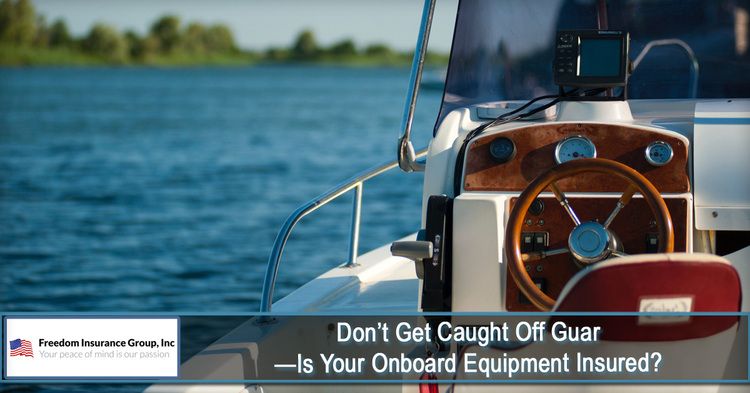
Boating is more than just a hobby—it’s a lifestyle. Whether you're fishing, cruising, or enjoying a weekend getaway on the water, your boat is likely equipped with valuable gear. From navigation systems and sonar to fishing tackle and entertainment devices, onboard equipment adds significant value to your vessel.
But here’s a question many boat owners forget to ask until it's too late:
Is your onboard equipment actually covered by your boat insurance policy?
In this guide, we’ll explore what boat insurance typically includes, which types of equipment are covered, and how to make sure your gear is fully protected.
What Is Considered Onboard Equipment?
Onboard equipment includes any items or systems installed or carried on your boat that are used for safety, navigation, comfort, or recreation.
Common examples include:
- Electronics: GPS, fish finders, radios, chartplotters
- Safety gear: Life jackets, fire extinguishers, flares
- Fishing equipment: Rods, reels, tackle boxes
- Comfort items: Deck furniture, grills, coolers, stereo systems
- Water toys: Tubes, skis, paddleboards
These items can range from a few hundred to several thousand dollars—making insurance coverage critical.
Does Standard Boat Insurance Cover Onboard Equipment?
The answer: it depends.
While many boat insurance policies do include some coverage for onboard equipment, there are often limitations and exclusions.
Here’s what standard coverage may include:
1. Permanent Fixtures
- Items permanently installed or built into the boat (e.g., sonar systems, hardwired electronics) are usually covered under the hull or equipment portion of your policy.
2. Personal Property
- Some policies provide limited coverage for removable personal property used in connection with the boat (like fishing gear or coolers).
- This is typically capped at a fixed amount (e.g., $1,000 or $2,500), unless additional coverage is added.
3. Theft and Damage
- Covered if the incident occurs while the boat is stored or actively in use, but certain items may only be covered if stolen from a locked compartment or secured location.
Not automatically covered:
- Expensive portable gear (e.g., drones, laptops, cameras)
- Equipment not permanently affixed to the vessel
- Items used for commercial or tournament purposes
How to Ensure Your Equipment Is Properly Insured
To avoid unexpected claim denials, take these proactive steps:
1. Review Your Policy Carefully
- Look for sections covering “Personal Effects,” “Navigation Equipment,” or “Scheduled Equipment.”
- Check for limits on theft, wear-and-tear exclusions, and deductibles.
2. Take Inventory
- Document all onboard items with photos, receipts, and serial numbers.
- Maintain a list in case you need to file a claim.
3. Add Scheduled Coverage or Riders
- High-value items like fishing equipment or electronics can often be scheduled separately for full-value coverage.
- Ask your insurer about endorsements or add-ons for gear that exceeds your standard policy limits.
4. Secure Your Equipment
- Use lockable storage and security alarms to reduce theft risk and comply with your policy terms.
5. Bundle with Homeowners or Specialty Insurance
- If items are removable and used elsewhere (e.g., cameras), they may be better covered under homeowners or renters insurance, especially if not used exclusively on the boat.
Pro Tip: Always notify your insurer when adding new expensive equipment to your boat.
What Happens If You File a Claim?
When filing a claim for damaged or stolen onboard equipment:
- Provide proof of ownership (photos, receipts, or valuations)
- File a police report if theft is involved
- Understand your deductible—you may only be compensated for amounts exceeding it
- Know your coverage limits—standard policies may not pay the full replacement value unless you have scheduled coverage
Timely reporting and thorough documentation improve your chances of a smooth claim process.
Conclusion: Don’t Let Uninsured Equipment Sink Your Fun
Your boat is more than just a vessel—it’s a collection of tools, gear, and comforts that make every trip safer and more enjoyable. Failing to properly insure your onboard equipment could lead to significant financial loss in the event of damage, theft, or accident.
To recap:
- Review your boat insurance policy for onboard equipment coverage
- Document your equipment and keep receipts
- Consider adding scheduled coverage for high-value items
- Secure your gear and follow safety protocols
- Consult your insurer to close any coverage gaps
Peace of mind on the water starts with knowing everything onboard is fully protected.
At Freedom Insurance Group, Inc., we aim to provide comprehensive insurance policies that make your life easier. We want to help you get insurance that fits your needs. You can get additional information about our products and services by calling our agency at 828-322-7474. Get a free quote today by CLICKING HERE.
Disclaimer: The information presented in this blog is intended for informational purposes only and should not be considered as professional advice. It is crucial to consult with a qualified insurance agent or professional for personalized advice tailored to your specific circumstances. They can provide expert guidance and help you make informed decisions regarding your insurance needs.
